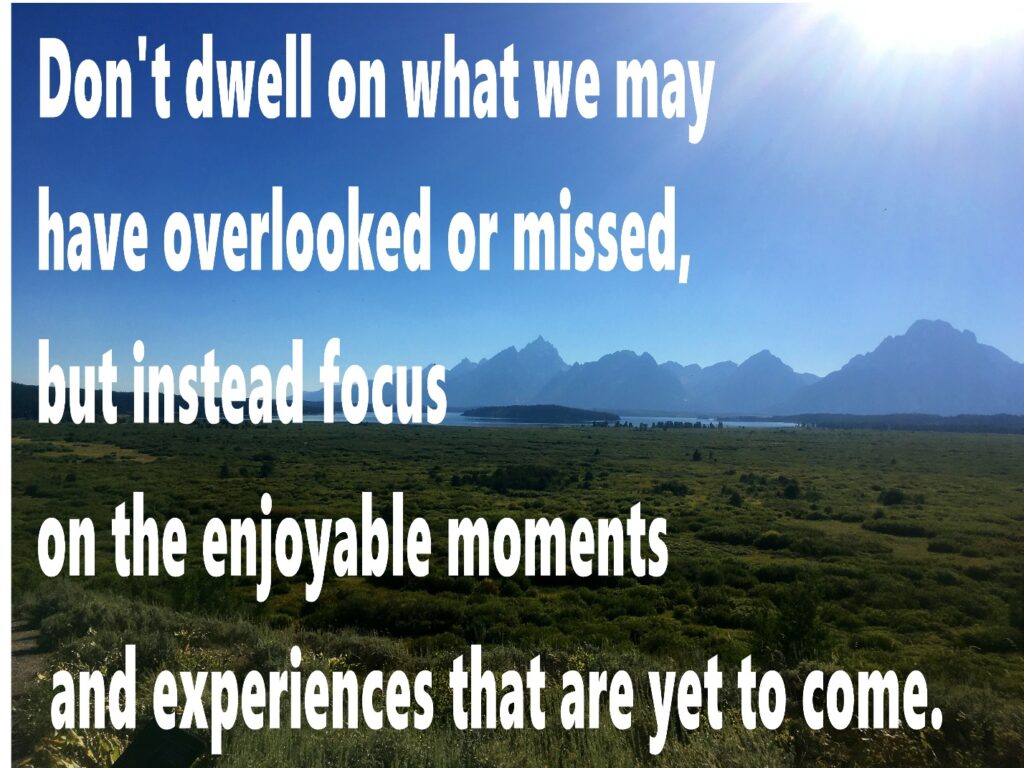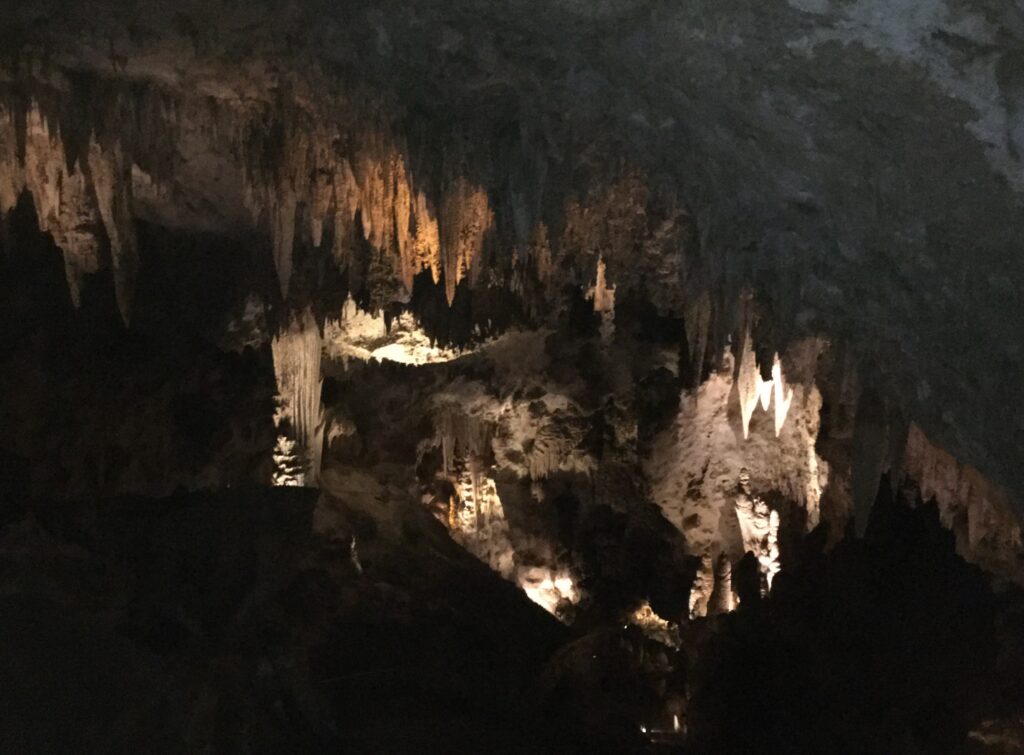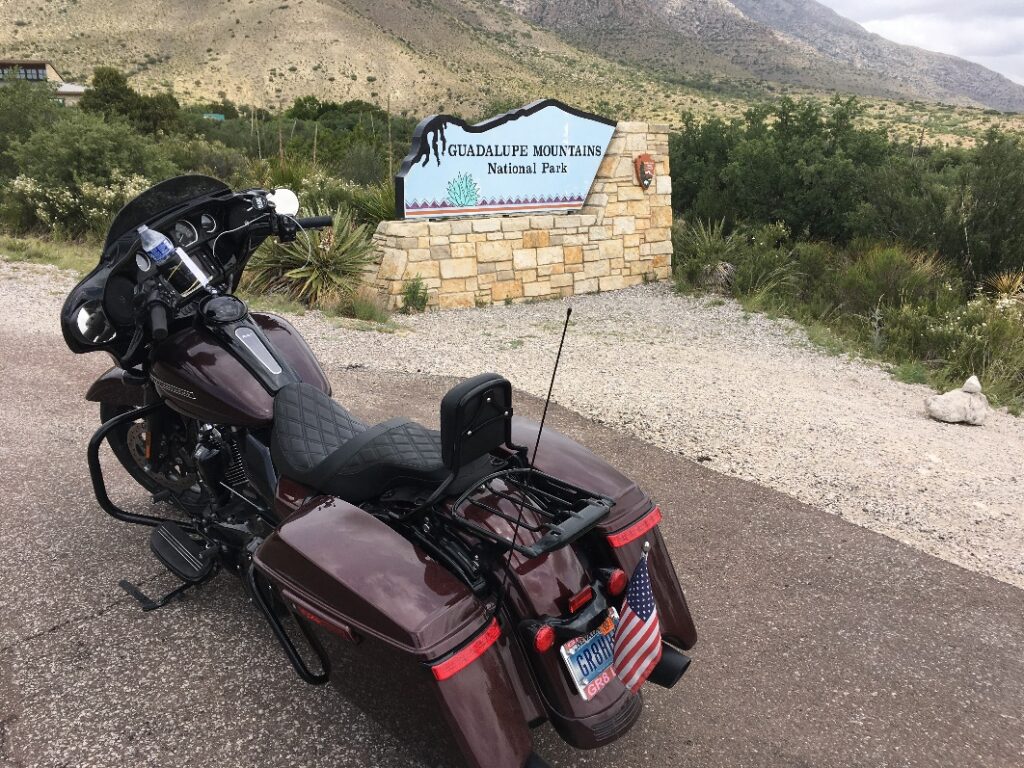On July 26, 1923, in Maud Noble’s cabin at Menor’s Ferry, Moose, WY a group of locals gathered to have a conversation about protecting the area from further development. They wanted to leave the area undeveloped and pristine. A hundred years later we have the pleasure of traveling through the Grand Teton National Park. The name derived from French-Canadian trappers who accompanied the earliest British expeditions into this territory. As they approached the range from the west, they beheld three towering mountains upon which they bestowed the name of “Trois Tetons” (Three Breasts) or so the story goes.
The Grand Teton National Park boundaries include approximately 310,000 acres, 485 square miles. And I have only allotted about a day and a half to take in the glorious mountains, forests, lakes, rivers, and hopefully some wildlife. After the presentation with the Park Ranger, it will be my desire Not to encounter any bears.
Only one day and a half to explore:
Stop #1
Drop in on a ranger presentation about bears and bear safety. The ranger demonstrated the proper usage of bear spray which is to use it when the bear is coming towards you. The main thing is to not spray it all at once, as the bear may retreat, and then come back. You don’t want to have an empty can of bear spray when the angry bear is charging. Once you have emptied your can you need to leave the area immediately and report the incident to a ranger. Apparently, the spray once deployed will end up acting as an attractant.
Yellowstone is home to both black bears and grizzly bears. The bears are at the top of the Yellowstone food chain, which puts you and me after the bear. Although big, fury, and bearing sharp teeth and claws, bears do not like interacting with us. Unless attracted by food, bears will go out of their way to avoid humans.
A bear in the distance: If the bear sees you, retreat slowly and leave the area. If possible, slowly walk upwind to let your scent reach the bear. If a bear stands up on two legs, it’s probably trying to gather information about you rather than being aggressive. Don’t panic: just slowly back away.
If the bear clacks its teeth, sticks out its lips, huffs, woofs, or slaps the ground with its paws, it is warning you that you are too close and are making it nervous. Heed this warning and slowly back away. Do Not drop to the ground and “play dead.” Do Not run, shout, or make sudden movements: you don’t want to startle the bear. Running may trigger a chase response in the bear and you can’t outrun a bear.
Slowly putting distance between yourself and the bear may defuse the situation. Draw your bear spray from the holster, remove the safety tab, and prepare to use it if the bear charges.
Charging Bears
If a bear charges you after a surprise encounter, stay still and stand your ground. Most of the time, the bear is likely to break off the charge or veer away. If you run, you’re likely to trigger a chase response from the bear. If you have bear spray, this is the time to use it. Start spraying the charging bear when it is about 60 feet away or less.
If the bear continues to charge, it’s important not to drop to the ground and “play dead” until the bear makes contact, or the second before the bear makes contact.
If the Bear makes Contact:
Drop to the ground; put your arms over the back of your neck for protection. If you have a backpack good. Keep it on. Lie on your stomach and clasp your hands over the back of your neck with your elbows protecting the sides of your face. Remain still and stay silent, go limp to let him know he wins, that you are not a threat. Just curious how easy it is to go limp when being attacked by a bear?
During a surprise encounter where the bear is reacting defensively, you should not fight back. Fighting back will only prolong the attack and will likely result in more serious injuries. Apparently, since 1970 people who played dead when attacked by a bear during a surprise encounter in Yellowstone received only minor injuries. However, those who fought back during surprise encounters received very severe injuries.
Curious or Predatory Bears
Unlike a defensive bear that charges with its head low and ears laid back, a curious or predatory bear may slowly but persistently approach with its head up and ears erect. It may not use threat displays like huffing, blowing, barking, jaw-popping, hop charging, ground slapping, or bluff charging.
If you’re attacked by a curious or predatory bear, fight back using any available weapon (bear spray, rocks, sticks) to stop the bear’s aggression. Fight back as if your life depends on it because it does. Predatory attacks usually persist until the bear is scared away, overpowered, injured, or killed.
During this presentation, I asked for clarification on how to tell the difference between a defensive bear from a curious predatory bear. Essentially it seems the one that will attack you will act more congenially, appear more curious, dare I say friendly, than that of the defensive bear. Going against my natural reaction, do we see some similarities to predators in people? Either way, I have determined, that I do not want to come across any bears on this trip, defensive or predatory. Happy to report no bears were spotted by me. Well, except for the scared bear running across the street around Sleeping Bear National Lakeshore while I was on my motorcycle. Both the bear and I agreed to keep our distance from each other.
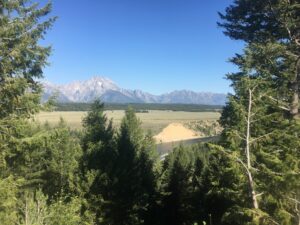
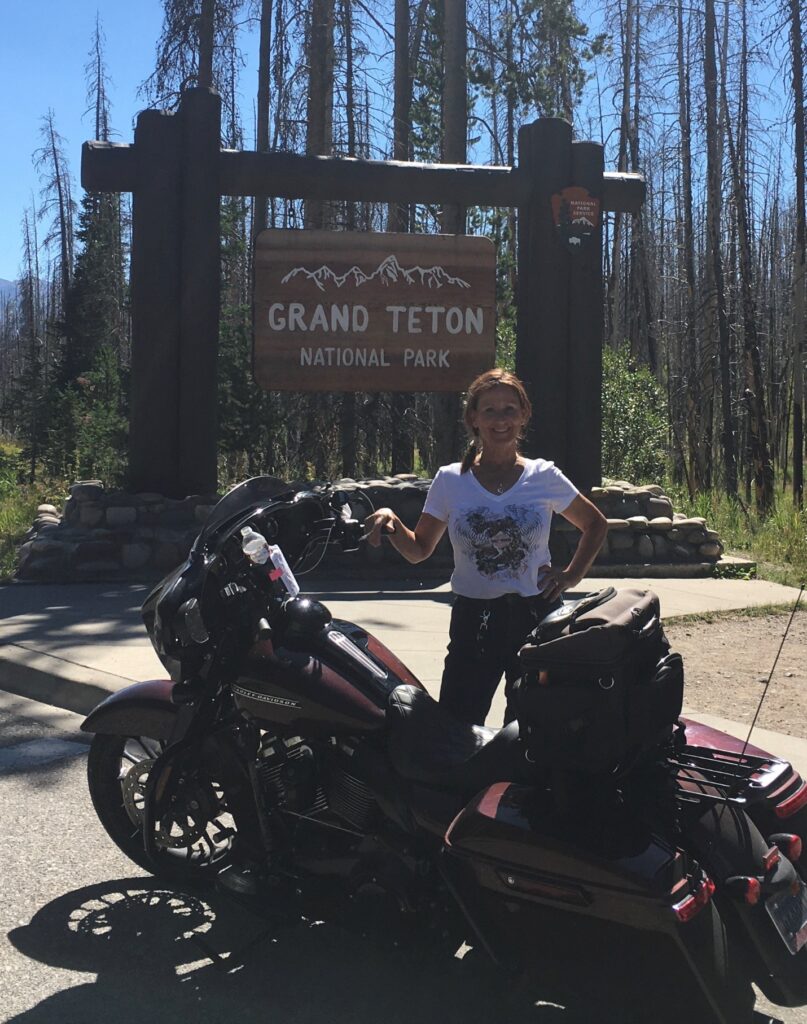
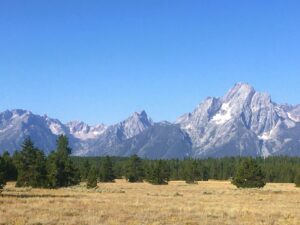
At the Flagg Ranch Information Station, I met with a most informative Park Ranger, I asked him “If you only had four hours to tour the park what would you do?”
He rolled his eyes at me. Which I understood to be asking, “Why would you come to this spectacular park for only four hours!”
I agree. Grand Teton National Park is worth a minimum of several days. On a private note, I have been to this park on numerous occasions and discovered new places, and scenery which always bring inspiration and joy. One previous outing was to Colter Bay and the scenic boat tour, was worth it. A quaint village, with an excellent backdrop.
Stop # 2
Today it will be a beverage and light snack at Jackson Lake Lodge. They have outdoor seating overlooking the lake with a perfect view of the Grand Tetons. I took a small hike along the trail to the east of the lodge.
Stop # 3:
Take Highway 191 which runs through the park between Yellowstone and Jackson Hole. These travel routes offer outstanding mountain vistas and wildlife viewing opportunities. There are many places to pull off the side of the road, get out of the car or off your bike, and enjoy the phenomenal sites. It took billions of years, of natural forces including earthquakes, glaciers, and erosion to create this magnificent landscape.
When we travel, my hope is that we don’t dwell on what we may have overlooked or missed, but instead focus on the enjoyable moments and experiences that are yet to come.
Some History of The Grand Tetons
It all began on July 26, 1923, with a conversation in Maud Noble’s cabin at Menor’s Ferry. A group of neighbors, ranchers, and business owners met with the superintendent of Yellowstone, Horace Albright to discuss protecting the area known as Jackson Hole, named after Davey Jackson, a fur trader living in the area during the late 1800s. The topography surrounding the area was referred to as a “Hole” by mountain men, eventually earning the name Jackson Hole.
In 1929 to protect the Teton Range and the lakes that stood at the foothills was recognized as Grand Teton National Park. In 1943 President Franklin D. Roosevelt issued a proclamation establishing Jackson Hole National Monument. The monument includes 32,000 acres of land that John D. Rockefeller, Jr. later donated to include in Grand Teton National Park. Eventually, in 1950, this led to the combining of the two units to become the present-day Grand Teton National Park.
Traveling is a great opportunity to step out of your comfort zone, reflect on the bigger picture, and learn about the world and yourself.
